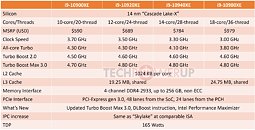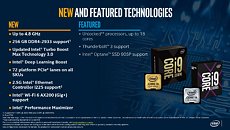Friday, October 4th 2019

Intel 10th Gen Core X "Cascade Lake-X" Pricing and Specs Detailed
Ahead of their October 7th product launch and November availability, we have confirmation of the specifications and pricing of Intel's 10th generation Core X "Cascade Lake-X" HEDT processors in the LGA2066 package. These chips feature compatibility with existing socket LGA2066 motherboards with a UEFI BIOS update, although several motherboard manufacturers are launching new products with some of the latest connectivity options, such as 2.5 GbE wired Ethernet, and 802.11ax Wi-Fi 6 WLAN.
The 10th generation Core X HEDT processor family is based on the new 14 nm++ "Cascade Lake" silicon, which comes with hardware fixes against several classes side-channel vulnerabilities, and introduces an updated instruction-set that includes more AVX-512 instructions, and the new DLBoost instruction. DLBoost leverages new fixed-function hardware on silicon to accelerate AI deep-learning neural-set building and training by up to 5 times. Intel's first wave of 10th gen Core X lineup is rather slim, with just four processor models. The company did away with the Core i7 brand extension, as core-counts in the mainstream desktop segment have already reached 8-core. The lineup now begins at 10-core/20-thread, with the chip's full 48-lane PCI-Express and 4-channel DDR4 interfaces enabled across the board. All models feature the "XE" brand extension, and feature unlocked base-clock multipliers.The Core i9-10900XE is your gateway to the series. This 10-core/20-thread chip comes with a fascinating price-tag of just USD $590, a significant drop from the $999 price for the previous-generation 10-core chip, the i9-9900X. It's clocked higher, with 3.70 GHz nominal, 4.50 GHz Turbo Boost 2.0, 4.70 GHz Turbo Boost Max 3.0 and 4.30 GHz all-core Turbo. The chip is endowed with 1 MB of dedicated L2 cache per core, and 19.25 MB of shared L3 cache.
The Core i9-10920XE is a $689 12-core/24-thread chip priced under AMD's upcoming flagship AM4 model, the Ryzen 9 3950X. It's marginally faster than its predecessor, the i9-9920X, with 3.50 GHz base clocks (same), 4.60 GHz Turbo Boost 2.0, 4.80 GHz Turbo Boost Max 3.0, and 4.30 GHz all-core turbo. Interestingly, the increase in core-count doesn't bring additional L3 cache, you get the same 19.25 MB.
The next step in this series is the $784 Core i9-10940XE, a 14-core/28-thread processor clocked at 3.30 GHz, with 4.60 GHz Turbo Boost 2.0, 4.80 GHz Turbo Boost Max 3.0, and 4.10 GHz all-core turbo. Yet again, you get just 19.25 MB of shared L3 cache. Interestingly, Intel did not plan a 16-core/32-thread model in this series, you jump straight to the flagship.
Leading the pack is the Core i9-10980XE, an 18-core/36-thread processor priced at a mouth-watering $979, which is less than half that of the previous-generation Core i9-9980XE. It ticks at 3.00 GHz, with 4.60 GHz Turbo Boost 2.0, 4.80 GHz Turbo Boost Max 3.0, and 3.80 GHz all-core turbo. You get a larger 24.75 MB of shared L3 cache. All four chips have their TDP rated at 165 W.
The 10th generation Core X HEDT processor family is based on the new 14 nm++ "Cascade Lake" silicon, which comes with hardware fixes against several classes side-channel vulnerabilities, and introduces an updated instruction-set that includes more AVX-512 instructions, and the new DLBoost instruction. DLBoost leverages new fixed-function hardware on silicon to accelerate AI deep-learning neural-set building and training by up to 5 times. Intel's first wave of 10th gen Core X lineup is rather slim, with just four processor models. The company did away with the Core i7 brand extension, as core-counts in the mainstream desktop segment have already reached 8-core. The lineup now begins at 10-core/20-thread, with the chip's full 48-lane PCI-Express and 4-channel DDR4 interfaces enabled across the board. All models feature the "XE" brand extension, and feature unlocked base-clock multipliers.The Core i9-10900XE is your gateway to the series. This 10-core/20-thread chip comes with a fascinating price-tag of just USD $590, a significant drop from the $999 price for the previous-generation 10-core chip, the i9-9900X. It's clocked higher, with 3.70 GHz nominal, 4.50 GHz Turbo Boost 2.0, 4.70 GHz Turbo Boost Max 3.0 and 4.30 GHz all-core Turbo. The chip is endowed with 1 MB of dedicated L2 cache per core, and 19.25 MB of shared L3 cache.
The Core i9-10920XE is a $689 12-core/24-thread chip priced under AMD's upcoming flagship AM4 model, the Ryzen 9 3950X. It's marginally faster than its predecessor, the i9-9920X, with 3.50 GHz base clocks (same), 4.60 GHz Turbo Boost 2.0, 4.80 GHz Turbo Boost Max 3.0, and 4.30 GHz all-core turbo. Interestingly, the increase in core-count doesn't bring additional L3 cache, you get the same 19.25 MB.
The next step in this series is the $784 Core i9-10940XE, a 14-core/28-thread processor clocked at 3.30 GHz, with 4.60 GHz Turbo Boost 2.0, 4.80 GHz Turbo Boost Max 3.0, and 4.10 GHz all-core turbo. Yet again, you get just 19.25 MB of shared L3 cache. Interestingly, Intel did not plan a 16-core/32-thread model in this series, you jump straight to the flagship.
Leading the pack is the Core i9-10980XE, an 18-core/36-thread processor priced at a mouth-watering $979, which is less than half that of the previous-generation Core i9-9980XE. It ticks at 3.00 GHz, with 4.60 GHz Turbo Boost 2.0, 4.80 GHz Turbo Boost Max 3.0, and 3.80 GHz all-core turbo. You get a larger 24.75 MB of shared L3 cache. All four chips have their TDP rated at 165 W.


124 Comments on Intel 10th Gen Core X "Cascade Lake-X" Pricing and Specs Detailed
I brain farted at 2am when I posted that... yes Xeon-w was released at Xeon prices in june but there have been more recent mentions of intel releasing i9 on the socket and there appears to be a 26 and 28c HEDT waiting in the wings to take on threadripper that is not the 3k chip. Competition is good. :)
Intel has double the L2 cache, but 1/3rd the L3 cache.
48 PCIe lanes, again? Is the fear of cutting into their server segment so big?
24 PCIe lanes from the PCH -> Bottleneck all your storage.
Just noticed, the 10 core (10900xe) is price wise up against the 3900x. I think the winner from that is clear.
But the mistake that many do is to extrapolate "general performance" of various CPUs based on Cinebench, which is very misleading considering Cinebench scales very differently from the CPU's actual "general performance" across a variety of workloads.
This is the 9980XE, which uses the 18-core HCC die. It is slightly below 500mm2 (around 21.6x22x4mm).
This is the Xeon W-3175X, which uses the 28-core XCC die. It is nearly 700mm2, at 21.6x32.3mm. There is no way that die can fit onto a Socket 2011 substrate - it's simply too large.
Which is why the 28-core is on socket LGA3647. Fitting that die onto a smaller substrate would not only require disabling a significant amount of I/O (due to loss of pins) but also redesigning the IHS and socket retention mechanism entirely. Not something Intel is likely to do.
They might be able to squeeze more cores in on 10nm, but that isn't arriving for chips this size any time soon. Yields would be utter garbage.
This topic is about Intel's HEDT. I've got a simple simon revelation for you now: HEDT means HIGH END DESKTOP, I couldn't care less how many dual-core mobile laptops Intel sells to insurance businesses, in the HEDT space, Intel is screwed so please try to come to terms with it.
I would not be surprised if larger core configurations would consist of two dies.
What this means for Ice Lake-X (and -W?) variants remain unknown.
Get it now?
There is no reason why a HEDT CPU with all memory controllers would compete with Xeon SP. HEDT is optimized for maximum performance and use "normal" ATX style motherboards, while Xeon SP is energy efficiency optimized and usually run on other motherboard form factors suitable for server racks.
I would prefer if Intel made one HEDT/workstation lineup like AMD does today, and enabled as many memory channels and PCIe lanes as possible. If they really have to sell some CPUs without all memory channels or ECC for yield issues, then they can sell these as cheaper CPUs on the same platform.
I said Intel plans to replace the 3175X either bringing i9 to 3647 or making another high binned Xeon-W
Guessing they will be using some of the dies they binned for cooperlake to try and stave off Threadripper 3000 total domination at a more reasonable TDP.
But in the June cascade lake refresh they did not release a 3175x replacement.
And the answer is: not really. AMD's advantage here stems from a bigger socket (SP3 vs 2066) and a smaller node, so they're able to fit more cores. That's it.
Keep in mind LGA2066 is just "high-end consumer" in the Intel's current lineup. They're not selling Xeons on this socket anymore (they're either LGA1151 or LGA3647).
If you just want to discuss HEDT as a separate lineup... there isn't really much to talk about. It's tiny and irrelevant. Even if 2066 just stopped selling today, it wouldn't have any impact worth discussing.
Xeon W-32XX is LGA3647
Xeon W-22XX is LGA2066
and still Xeon E-22XX is LGA1151
So the confusion continues…
Actually it takes some confusion away. The principle stands: Xeons are for production use (mission critical systems). Everything else does consumer + business (non-production).
Intel basically said: we can't put as many cores as we want on LGA1151 successor and OEMs told them LGA3647 is just too big.
I bet this wouldn't happen if Intel could put 16 cores on the small socket, but that's at least a year away.
When you start talking about large chips like these, power consumption is the key bottleneck and 14nm just doesn't seem to be cutting it anymore, no matter how many plus symbols you add after the 14.
TDP for laptops really matters, because thermal headroom and cooling is any laptop's biggest performance constraint.
AMD won't miss the one time opportunity to step on Intel and continue with their "New Leader-New Rules" ha?.
AMD should easily steal the thunder with better products, pricing, speed & performance.
So you you build a great workstation with great cooling you could bump the cTDP option for 300W~380W and get much higher clock.
This way it will be benched with this high performance and will be offered by System integrator's - same way they are OK with using Intel's MCE on since it's not voiding the warranty.